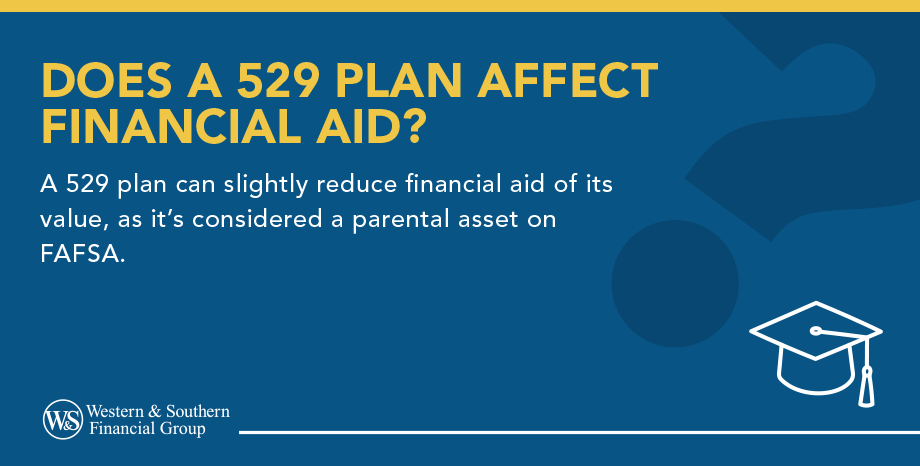

Key Takeaways
- 529 plans are state-sponsored savings accounts designed to help cover education expenses and contributions can grow tax-deferred.
- Withdrawals used for qualified education expenses are tax-free at the federal level while non-qualified withdrawals face a 10% penalty plus taxes.
- 529 plans owned by parents or students are considered assets when calculating financial aid eligibility and this can reduce aid somewhat.
- Beginning in the 2024–2025 academic year, withdrawals from grandparent-owned 529 plans no longer count as student income on the FAFSA.
- Despite potential financial aid impacts, saving with a 529 plan can help cover gaps between aid and actual college costs.
That's a common question many parents may ask. It's no secret that the costs of higher education have risen dramatically over the years. Today, most families need some sort of financial aid to cover the costs of room, board and education.
To help save for these future costs, some parents turn to 529 savings plans. A 529 plan can be set up while your child is still young to help cover qualified educational expenses down the road. But does a 529 plan count against financial aid? Here's some information to consider.
What Is a 529 Plan?
"529 plan" is short for 529 college savings plan. These plans are designed as savings vehicles to help cover qualified educational expenses.
You can set up 529 plans for your kids and even children who aren't your own, including grandchildren, nieces, nephews and family friends. There's no limit on the number of plans you can set up, though maximum contributions can apply.
Since these plans are run by each state, it's a good idea to check your state's particular rules and regulations.
One reason people often consider 529 savings plans is because contributions have the potential for tax-deferred growth. If the money is spent on qualified education expenses, you do not have to pay state or federal income tax. These expenses can include:
- Tuition and fees
- Books and required supplies
- Computers and related technology (including internet access, software, and printers)
- Room and board for students enrolled at least half-time
- Special needs services for students with disabilities
- K–12 tuition expenses (up to a certain limit per year)
- Student loan repayments (limited to a lifetime amount per beneficiary and sibling)
Any withdrawals that are not spent on qualified expenses are subject to a 10% withdrawal penalty on top of any income tax you pay on the gains. Per IRS regulations, qualified distributions of up to $10,000 are also allowed for K-12 tuition for public, private and religious schools.1
Understanding Financial Aid
Some students who need financial aid to cover school costs apply for federal aid using the Free Application for Federal Student Aid (FAFSA).2 After you complete the FAFSA form, the information you provide is used to calculate your expected family contribution (EFC). This is what the federal government believes you can contribute to higher education costs. You will also be granted a financial aid package that could include loans, grants, work-study programs or other forms of aid.
There are many factors that go into the formula that the federal government uses to determine a student's financial aid package. Among the primary factors are the student's and the parent or parents' assets, which can include income, benefits and even home value.
For many families, their financial aid package can fall well short of the total cost of a college or university, and it becomes necessary to fill the gap. That's where a 529 college savings plan may help to make a difference.
Does a 529 Plan Count Against Financial Aid?
529 plans are considered assets, so the amount of money you've saved in your plan is considered when figuring out your EFC. It can have an impact on the amount of financial aid you receive.3 Any increases in your EFC could be covered by what you've saved in your 529 plan.
Who Owns the Plan?
Student
If it's the student, then a larger percentage of the amount saved in the 529 is calculated into the formula compared with a parent-owned plan. In determining federal aid, the student is typically expected to contribute toward their own education, a higher percentage of their assets are typically used in the government's calculations.
Family Member or Friend
If owned by an outside friend or family member, then it is not counted in these financial aid considerations.
Grandparents
Under the FAFSA Simplification Act, starting with the 2024–25 school year, distributions from grandparent-owned 529 plans are no longer treated as student income and won’t affect eligibility for federal need-based aid. However, some colleges using the CSS Profile may still ask about them.
How to Start Saving for College
While 529 plans can affect financial aid, that impact may be smaller than the impact of not saving for college ahead of time. As your student approaches their college years, consider meeting with a registered representative for more information.
Start growing your education fund with a 529 plan designed for your goals. Invest Today
Frequently Asked Questions
Do you report your 529 plan on FAFSA?
What assets affect FAFSA?
Is a 529 considered income?
What happens to 529 if a child gets a scholarship?
Sources
- Tax Benefits for Education 2024. https://www.irs.gov/pub/irs-pdf/p970.pdf.
- Complete the FAFSA® Form. https://studentaid.gov/h/apply-for-aid/fafsa.
- Investor Alerts and Bulletins. https://www.sec.gov/about/reports-publications/investor-publications/introduction-529-plans.
- Parents. https://financialaidtoolkit.ed.gov/tk/outreach/target/parents.jsp.



























